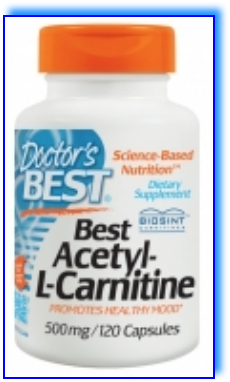What Is It?
• Best Acetyl-L-Carnitine (588 mg)
• Science-Based Nutrition
• Dietary supplement
• Beneficial antioxidant protection*
• Enhances alertness and mental focus*
• Supports energy metabolism in the brain*
• Keeps nerves healthy and in repair*
• Decreases free radical production in
Best Acetyl-L-Carnitine (588 mg)
• Science-Based Nutrition
• Dietary supplement
• Beneficial antioxidant protection*
• Enhances alertness and mental focus*
• Supports energy metabolism in the brain*
• Keeps nerves healthy and in repair*
• Decreases free radical production in
the brain*
Acetyl-L-Carnitine) is a naturally
ALC plays a key
Sigma Tau Acetyl-L-Carnitine in this product is derived from a base of pharmaceutical grade L-Carnitine manufactured by patented, FDA-approved process that fully complies with the USP 25, FCC 4 and EU monographs. It is GMO-free, pesticide-free and BSE safe.
SUPPLEMENT FACTS
Sigma Tau)
Non-GMO & Gluten Free
(
ALC) is a naturally
occurring form of L-Carnitine, a vitamin-like
nutrient synthesized in the body from the amino
acids lysine and methionine.
ALC plays a key
role in the production of acetylcholine, an
important neurotransmitter for brain and nerve
cell function.*
The
Sigma Tau Acetyl-L-Carnitine in this product is derived from a base of pharmaceutical grade L-Carnitine manufactured by patented, FDA-approved process that fully complies with the USP 25, FCC 4 and EU monographs. It is GMO-free, pesticide-free and BSE safe.
SUPPLEMENT FACTS
Serving size: 1 capsule
Servings Per Container: 60 servings
Amount Per Serving %DV
-----------------------------------------------------------------------------------------------------
Acetyl-L-Carnitine 500 mg †
(from 588mg acetyl-l-carnitine HCl
supplied by
Sigma Tau)
-----------------------------------------------------------------------------------------------------
† Daily Value not established.
Non-GMO & Gluten Free
Other Ingredients: Stearic acid, cellulose, magnesium silicate, silicon dioxide, gelatin (capsule).
Suggested Adult Use: Take 1 to 4 capsules daily with or without food. Higher intakes may be beneficial, as recommended by a nutritionally
: Stearic acid, cellulose, magnesium silicate, silicon dioxide, gelatin (capsule).
Suggested Adult Use: Take 1 to 4 capsules daily with or without food. Higher intakes may be beneficial, as recommended by a nutritionally
informed physician. Individuals with thyroid problems or on anticoagulant therapy should consult their physician before using this product.
Acetyl-L-Carnitine
(
ALC) is a naturally occurring form of L-Carnitine, a vitamin-like nutrient synthesized in the body from the amino acids lysine and methionine.
ALCserves as a transport molecule for “active acetate,” which is a source of fuel for metabolic processes that take place in cells.
ALCcarries active acetate (the “Acetyl” portion) directly into the mitochondrion, the cell’s energy-generating structure. Active acetate is used to produce cellular energy in the form of ATP. Both L-Carnitine and
ALCserve as fat carriers. Unlike L-Carnitine,
ALCreadily crosses the blood-brain barrier, where it has specific benefits for brain neurons. When taken orally,
ALChas been shown to promote healthy
ALClevels in both blood and cerebrospinal fluid, demonstrating its uptake in the brain.
1
Best Acetyl-L-Carnitine
contains Biosint™ Acetyl-L-Carnitine, which is manufactured in Italy by the reputable company
Sigma-Tau. It is derived from a base of pharmaceutical grade L-Carnitine manufactured using an FDA approved process that fully complies with international monograph standards for carnitine production. Known as a global leader in L-Carnitine research, Sigma-Tau holds numerous patents for production of L-Carnitine, the derivatives of which are used in clinical trials.
Best Acetyl L-Carnitine
Supports Cognitive Function*
ALC
has been studied for its effect on cognitive performance and emotional health in the elderly. In a single-blind, placebo-controlled trial, 481 elderly subjects taking 1500 mg of
ALCper day were found to have improved scores on a memory test assessing cognitive abilities after 90 days of
ALCsupplementation.
2In addition to being known for its effects on recognition and memory, placebo-controlled
ALCresearch has also shown better scores in scales measuring the mood of elderly people.
2, 3
Benefits
Supports Biosynthesis of Acetylcholine, a Key Neurotransmitter for Brain and Nerve Function*
ALC
Brain function requires coordinated communication between brain cells. Neurons (brain & nerve cells) communicate across tiny cell-to-cell gaps called synapses. The passage of an electrical impulse from one neuron to the next requires a neurotransmitter to act as a messenger to pass signals to adjacent neurons. When an electrical signal arrives at the synaptic junction, the neuron releases a neurotransmitter into the synapse. The neuron on the other side of the synapse contains receptors for the neurotransmitter (that will bind it), triggering a series of chemical events to send a new electrical signal down the membrane of the receiving neuron. Neurotransmitters work together like an orchestra to transmit information throughout the brain and nervous system.
Acetylcholine is the most abundant neurotransmitter in the body, regulating activities of vital organs and blood vessels, and communication between nerves and muscles. In the brain, acetylcholine helps to facilitate memory and learning, as well as influencing emotions.
ALCis structurally similar to acetylcholine- enough so that brain neurons stimulated by acetylcholine are receptive to stimulation by
ALC.
4In an experimental animal model, it was shown that
ALCcan furnish acetyl groups to be utilized during the natural biosynthesis of acetylcholine.
5ALC
’s structural similarity to acetylcholine has led researchers to investigate its effects on mental function and emotional health.
6
Helps Supply the Brain With Energy Through Mitochondrial Efficiency*
ALC
The acetyl groups donated by
ALCcan be used to naturally synthesize acetyl-CoA, the key substrate for energy metabolism in the mitochondrion.
1Acetyl-CoA enters the Krebs cycle, the mitochondrial pathway that generates cellular energy in the form of ATP. Age-related decreases in mitochondrial oxidative capacity are a well-known cause of aging, as the organelles and organs in the body begin to operate less efficiently without ideal ATP production. The effects of decreased mitochondrial oxidative capacity are especially prevalent in organs that require high-energy inputs, such as the brain and heart. Recent clinical studies have shown that
ALChelps to promote and maintain healthy mitochondrial function.
7
Helps Uphold the Integrity of Intracellular Membranes*
ALC
Phospholipids are structural components of brain cell membranes that regulate neuronal function.
ALChas been shown to promote healthy membrane phospholipid metabolism in research subjects.
8Additionally, the acetyl groups in
ALCare naturally utilized by the body to modify the activity of proteins in neuronal membranes.
1Through these means,
ALCpromotes normal membrane function, stability, and structural integrity.
9
Supports Nerve Growth Factor Production*
ALC
ALC
The body produces specialized proteins called growth factors that are essential to the growth and repair of tissue. Nerve Growth Factor (NGF) prolongs the survival of neurons in both the central and peripheral nervous systems. As we age, our central nervous system experiences a decrease in the binding of NGF to neuron membranes.
ALChas shown the ability to promote the maintenance of normal interactions between NGF and neuron membranes.
10
Given to aged rats,
ALCdemonstrated effectiveness in promoting normal levels of NGF, and it helped maintain utilization of the growth factor in the rats throughout the duration of the study. Maintaining ideal levels of NGF is essential for the health of cholinergic neurons (nerve cells stimulated by acetylcholine), as cholinergic neurons lose some functional capacity due to a lack of NGF. In aged rats,
ALCis known to promote the health of cholinergic neurons.
11In sum, such results suggest that
ALCpositively influences the maintenance of healthy and normal NGF activity.
1
Supports Healthy Brain Neuron Function*
ALC
ALC is a
16
Several animal studies have revealed that
ALCcontains many biochemical characteristics that help neurons face the aging process optimally.
12, 13has been shown to raise levels of glutathione, a key antioxidant, in isolated mouse brain tissue.
14ALC
also reduces blood levels of MDA (malondialdehyde), a free radical byproduct.
15Furthermore,
ALC is a
chelator of iron: it acts as a molecule that can naturally sequester iron in the body to prevent iron-mediated oxidative damage to cells.
16As a whole, data from in vitro and animal studies suggest that
ALCis effective towards the maintenance of healthy brain neurons and normal neuronal energetic processes. This hypothesis is supported by human studies that demonstrate the potential of
ALCto promote healthy brain function in elderly persons.
17
INGREDIENTS
ALC serve as fat carriers.
ALC. It is derived from a base of pharmaceutical grade
Sigma-Tau
Acetyl-L-Carnitine (
ALC) is a naturally occurring form of L-Carnitine, a vitamin-like nutrient synthesized in the body from the amino acids lysine and methionine.
ALCserves as a transport molecule for “active acetate,” which is a source of fuel for metabolic processes that take place in cells.
ALCcarries active acetate (the “Acetyl” portion) directly into the mitochondrion, the cell’s energy-generating structure. Active acetate is used to produce cellular energy in the form of ATP. Both L-Carnitine and
ALC serve as fat carriers.
Unlike L-Carnitine,
ALCreadily crosses the blood-brain barrier, where it has specific benefits for brain neurons. When taken orally,
ALChas been shown to promote healthy
ALClevels in both blood and cerebrospinal fluid, demonstrating its uptake in the brain.1 Best Acetyl-L-Carnitine contains Biosint™ Acetyl-L-Carnitine, which is manufactured in Italy by the reputable company
Sigma-Tau. It is derived from a base of pharmaceutical grade
L-Carnitine manufactured using an FDA approved process that fully complies with international monograph standards for carnitine production. Known as a global leader in L-Carnitine research,
Sigma-Tauholds numerous patents for production of L-Carnitine, the derivatives of which are used in clinical trials.
* These statements have not been evaluated by the
Food and Drug Administration.
This product is not intended to diagnose, treat, cure, or prevent any disease.
Food and Drug Administration.
This product is not intended to diagnose, treat, cure, or prevent any disease.
REFERENCES
1.Pettegrew, J.W., J. Levine, and R.J. McClure, Molecular Psychiatry, 2000.
5 (6): p. 616-632.
2.Salvioli, G. and M. Neri, Drugs Exp Clin Res, 1994. 20(4): p, 169-76.
3.Tempesta, E., et al., Drugs Exp Clin Res, 1987. 13(7): p. 417- 23.
4.Falchetto, S., G. Kato, and L. Provini, Can J Physiol Pharmacol, 1971.
49(1): p.1-7.
5.Dolezal, V. and S. Tucek, J Neurochem, 1981. 36(4): p. 1323-30.
6.Passeri, M., et al., Int J Clin Pharmacol Res, 1988. 8(5): p. 367-76.
7.Rosca, M.G., H. Lemieux, and C.L. Hoppel, Adv Drug Del Rev, 2009.
61(14): p.1332-42.
8.Pettegrew, J.W., et al., Neurobiol Aging, 1995. 16(1): p. 1-4.
9.Arduini, A., et al., Life Sci, 1990. 47(26): p. 2395-400.
10.Taglialatela, G., et al., Biochem Pharmacol, 1992. 44(3): p. 577- 85.
11.Taglialatela, G., et al., Exp Gerontol, 1994. 29(1): p. 55-66.
12.Forloni, G., N. Angeretti, and S., J Neurosci Res, 1994. 37(1): p. 92-6.
13.Steffen, V., et al., Hum Exp Toxicol, 1995. 14(11): p. 865-71.
14.Fariello, R.G., et al., Life Sci, 1988. 43(3): p. 289-92.
15.Calvani, M., et al., Ann N Y Acad Sci, 1992. 663: p. 483-6.
16.Calvani, M. and A. Carta, Dementia, 1991. 2: p. 1-6.
17.Hathcock, J.N. and A., Regul Toxicol Pharmacol, 2006. 46(1): p. 23-8

DOCTOR'S BEST











To Order - Phone: (773) 472-2395
WWW.VITAL-NUTRIENTS.COM
This website collects absolutely NO user information for any reason whatsoever. We only use personal phone contact when you call.

Once again, on any product that I carry, I will do my best to go
beyond my regular customer discount and meet any
bona fide price advertised on the Internet.
For reasons stated earlier, I do not correspond by email.
For more information or to place an order, please call me at:
beyond my regular customer discount and meet any
bona fide price advertised on the Internet.
For reasons stated earlier, I do not correspond by email.
For more information or to place an order, please call me at:
The products presented on this website are dietary food supplements,
not medicines. No curative claims are made.
The statements on this website have not been evaluated by the FDA.
not medicines. No curative claims are made.
The statements on this website have not been evaluated by the FDA.
ALL PRODUCTS and PRODUCT NAMES on this website are
copyrighted, registered, or trademarked by the manufacturing company.
copyrighted, registered, or trademarked by the manufacturing company.
-Ron Pellegrini
(773)472-2395
Thank you,
But please be sure to have first read my HOME PAGE.
- Vital Nutrients Home
- AHCC
- Behavior Balance
- Best Acetyl-L-Carnitine
- Betain HCL Pepsin Gentian Bitters
- Bio-D-Mulsion Forte Vitamin D
- BIOTICS RESEARCH
- CapraCleanse
- CELLFOOD
- CELLFOOD DNA-RNA
- CELLFOOD Silica
- Clinical Glutathione
- Coconut Oil by SKINNY
- Curaphen
- Curapro
- DIM Plex
- Doctor's Best Products
- E3 Live
- Fungal Defense
- FYI Ultra
- Garden of Life Products
- Goatein
- Indium XL
- Living Calcium Advanced
- Lypo-Spheric Vitamin C
- MegaHydrate
- Nattokinase
- Neprinol
- Olde World Cod Liver Oil
- OmegaZyme Ultra
- OlivFactor - formerly T.O.O.L.E.
- Perfect Food
- Primal Defense
- Quercetin Bromelain
- Radical Fruits
- RM-10 Ultra
- Rosavin
- Russian Choice Immune
- Serrapeptase
- Stabilized R Alpha Lipoic Acid
- Sweet Wheat
- Garden of Life Vitamin Code
- Vitamin Code Family
- Vitamin Code Kids
- Vitamin Code Men
- Vitamin Code Men 50 & Wiser
- Vitamin Code Women
- Vitamin Code Women 50 & Wiser
- VitaPQQ
- Helpful Links
- Contact Us



Alphabetical Product Menu